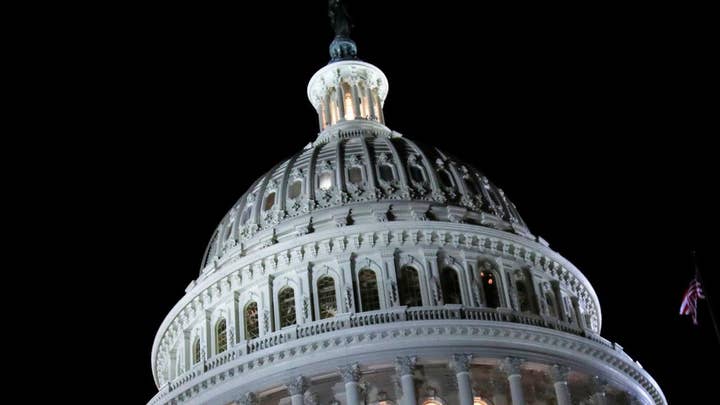CAPITOL HILL – Senate Republicans have been chatting again about efforts to initiate a third “nuclear option” to alter Senate precedent and accelerate the confirmation of some lower-tier nominations. The effort is seemingly gathering steam and starting to command headlines.
Bottom line: this ain’t gonna happen any time soon.
To be clear, there is zero talk about eliminating filibusters for legislation. This is only a discussion about modifying current Senate practice for some nominees. And it’s not even about cutting off filibusters. It’s about shortening the time between a successful vote to end a filibuster and when the Senate votes to confirm a nominee. That’s why it may not even be accurate in portraying this goal as the “nuclear option.” It’s more the equivalent of a “suitcase nuke.”
To wit: Each week after the Senate GOP policy lunch, Sen. Roy Blunt, R-Mo., takes to the microphones alongside Senate Majority Leader Mitch McConnell, R-Ky. Blunt routinely makes a pitch for a change.
Senate rules permit up to 30 hours of debate once the Senate votes to end debate on any nominee. The Republican proposal would maintain the 30-hour window for Supreme Court justices, cabinet officials, high-level administration nominees and Circuit judges. Republicans would like to condense the time to a mere two hours of debate after voting to end a filibuster. This would speed things along considerably. Republicans have leveled criticism at Democrats for forcing senators to burn 30 hours at repeated intervals despite little opposition to some nominees.
The Senate currently requires a simple majority -- 51 votes -- to overcome a filibuster on any nomination. Senators have no intention of dropping that bar any further; 60 votes are still required to end a filibuster on legislation. The process of ending a filibuster is called “invoking cloture.” The Senate permits up to 30 hours of debate after “invoking cloture” on any issue or nominee. Sometimes the Senate just sits in stasis for hours, “burning” time off the clock “post-cloture.” This is the practice Blunt and others hope to truncate.
If Republicans wish to abbreviate the “post-cloture” time, they need to have at least a simple majority of senators who wish to establish a new precedent. And, they likely have to follow the playbook used for Nuclear Option I in November 2013 on all administration nominees except the Supreme Court and Nuclear Option II for Supreme Court nominees themselves.
Some background: “The Nuclear Option” is an extreme parliamentary maneuver to establish new Senate precedent, not a rules change. The Senate has 44 “standing rules.” However, the book of “precedents” is voluminous. Most of what the Senate does is based on precedent, not standing rules. Moreover, it takes 67 votes to end a filibuster on a rules change. That’s right: not 60 yeas, but 67. However, establishing a new precedent requires a simple majority. That’s a lot easier than rounding up 67 votes.
In November, 2013, Senate Democrats -- then in the majority -- initiated the nuclear option. They lowered the bar to break a filibuster from 60 yeas to 51 yeas on all executive branch nominees such as federal judges and cabinet secretaries, except the Supreme Court.
It is said that paybacks are hell. In April 2017, Republicans -- now in the majority -- initiated a nuclear option of their own, dropping the filibuster bar for Supreme Court nominees. That’s how they confirmed Supreme Court Justice Neil Gorsuch, and later, Justice Brett Kavanaugh.
Here’s what established the current “precedent” under which the Senate operates.
Gorsuch faced a filibuster. His nomination had more than 51 yeas for confirmation. But, he lacked 60 to end the filibuster. The Senate voted to close debate on Gorsuch’s nomination (cloture). But that roll call came up short -- a failed cloture vote.
This is key and where the “nuclear option” comes in. McConnell obviously supported ending debate on the Gorsuch nomination. But, he switched his vote at the end of the failed cloture vote from yea to nay. The Senate allows senators to “revote” issues if they are on the prevailing side of the issue. In other words, Gorsuch got a simple majority. But the “no” votes prevailed. So, McConnell became a “no,” giving him the option of asking the Senate to “reconsider” the failed vote and take another run at invoking cloture.
TRUMP TELLS REPUBLICANS TO 'STAY UNITED' IN FACE OF PUSH TO NIX BORDER EMERGENCY DECLARATION
Once McConnell switched his vote, he then could move to proceed to the failed cloture vote. That only needed 51 yeas. Then, he made a motion for the Senate to retake the failed cloture vote on Gorsuch. That also needed just a simple majority. So, after those parliamentary gymnastics, the Senate had returned to the failed cloture vote.
It is often said that the Senate has “unlimited debate.” Not really. There are only a few parliamentary cul-de-sacs in which the Senate harnesses debate. The do-over of a failed vote to end debate is one of them. This is where McConnell lit the fuse on Nuclear Option II.
McConnell simply followed the precent established by then-Senate Majority Leader Harry Reid, D-Nev., for Nuclear Option I in 2013. Senate Rule XXII (22) governs cloture in the Senate. So, McConnell raised a point of order that “the vote on cloture under Rule 22 for all nominations to the Supreme Court is by a majority vote.” A “point of order” is where a senator questions whether the Senate is operating under correct procedure. And, in fact, up until then, it had. It took 60 votes to end a filibuster on a Supreme Court nominee. But, what McConnell was asserting was that the Senate wasn’t operating under current procedure.
Senate Parliamentarian Elizabeth MacDonough ruled against McConnell, citing the Senate’s established precedent of 60 votes, not 51, to break a filibuster. McConnell was informed that the “point of order is not sustained.”
But, McConnell then asked the Senate to override the ruling. The Senate then would vote on “Shall the decision of the Chair stand as the judgment of the Senate?”
That initiated another roll-call vote. Republicans voted nay. After all, they didn’t want the “decision of the Chair” based on old Senate precedent to stand. So, if a majority of senators voted against the ruling, the Senate would establish a new precedent. In this instance, Republicans were rooting for the “no” votes to prevail.
In short, that’s the nuclear option.
If Senate Republicans want to prune the time the Senate can burn after stopping a filibuster, they’ll have to follow the template spelled out above.
Therein lies the rub:
Unless someone comes up with a new idea to change Senate precedent, senators must replicate the parliamentary posture it assumed when Reid moved Nuclear Option I in 2013 and when McConnell advanced Nuclear Option II in 2017. And, McConnell would have to have 51 senators willing to go along with his gambit.
CLICK HERE TO GET THE FOX NEWS APP
The 116th Congress is only two months old. The Senate has no failed cloture votes on a nomination available for a revote at this stage. It’s unclear if and when the Senate could ever witness a failed cloture vote. Republicans may have hoisted themselves by their own petard here. After all, it’s now harder for the Senate to derail a nomination via a filibuster. The current precedent requires just a simple majority to end debate on a nomination. There are now 53 Republicans in the Senate. McConnell, Blunt and other supporters of this “suitcase nuke” tactic would have to find a Trump administration nominee who can’t even clear the meager filibuster bar. That’s a challenge. And, would Senate GOP leaders really want to use this artifice to confirm someone senators don’t want to confirm – just to establish a new precedent? That’s playing with Senate fire.
So, there may be a lot of talk in the coming weeks of a new “nuclear option,” efforts to step up the pace to confirm nominees, killing off the 30-hour clock. It makes good copy and conversation. But, no one should pay it much mind until the Senate fails to end debate on a Trump administration nominee, putting the Senate in the proper parliamentary posture to hit the red button.








